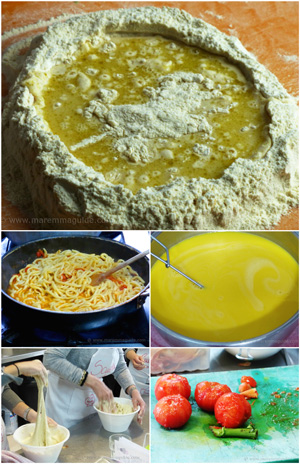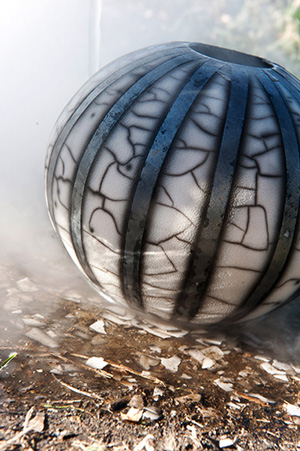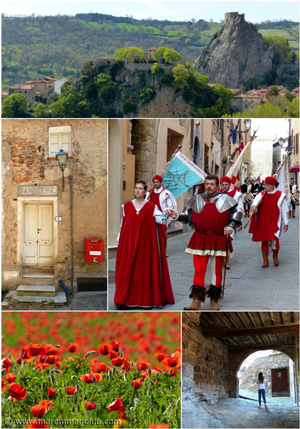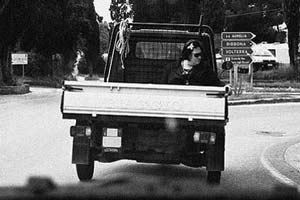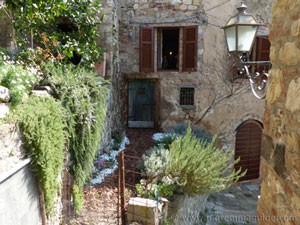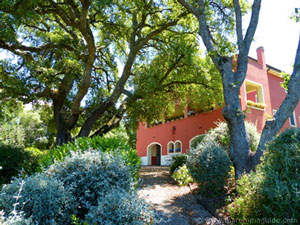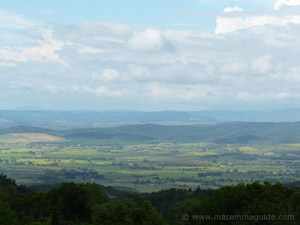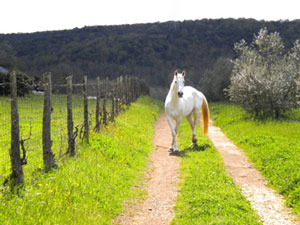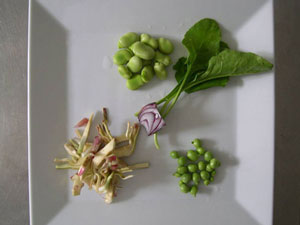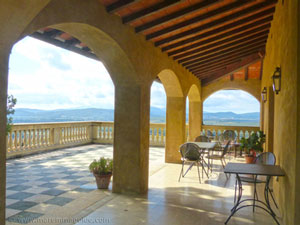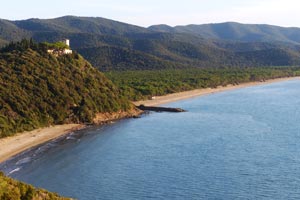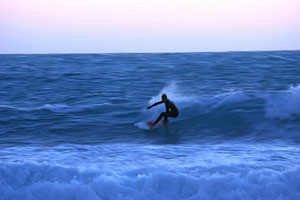The insediamento rupestre di San Rocco
spine-tingling spooks in Sorano
For many, the "insediamento rupestre di San Rocco", on the tufa rock outcrop across the Lente river gorge at Sorano, will always be just a copse with a couple of rocky floor clearings with panoramic views of the town. A tiny, boring looking church that isn't open to look inside anyway. And some holes in the same said rock.
But.
Touch that rock. Walk into those "holes". And you will enter a world of early humans. The homes of pre-historic man. Of Etruscan man. And medieval man. A human rock settlement right up to the end of the 18th century.
Where Stone Age woman lit the first fires in the entrance to her cave carved out of tufa rock. Where she gave birth on the leaf-covered floor. And pressed her spine hard into the deepest darkest recesses of her home when the sounds of the nocturnal pack of hunting wolves got too close for comfort.
The name "Sorano" is of Latin origin. It comes coming from an Etruscan-Faliscan-Sabine god. The evil Pater Soranus. The Sabine god of wolves and mountains. Who walked with the underworld gods. His priests, "Hirpi Sorani", the Wolves of Soranus, walked on fire carrying the entrails of their sacrificial victims.
Walk into the dark of the three large hollowed out caves under your feet. And run your fingers across their walls. Feel the fine chisel lines of Etruscan man who carved out these tombs for Sorano families living on the hill opposite. Some eight hundred years before Christ.
Out on the plateau, look at the rock beneath your feet. Really look. And find the small holes. Smoothed in profile with time. Filled with lichen, moss and leaf debris. They aren't natural. Get your eye in and they form a pattern. For once, rammed into them, were wooden posts. Posts that were the foundations and held the platforms of an ancient settlement.
Go to the look-out points and gaze in wonder at the scene in front of you. Sorano. Magical. Incredible. Intoxicating. Sorano.
And then. If you have time. Take a walk down one of the most atmospheric Vie Cave in the world. A vertical wonder. Hand hollowed out of tufa rock. Some twenty metres deep in places. That takes you down into the valley below. Across the confluence of three rivers. To Italy's most important historic rock settlement. Vitozza.
Then tell me that the insediamento rupestre di San Rocco (the rock settlement of San Rocco) is just a copse with some holes.
San Rocco is one of the least, as yet, archaeologically investigated sites in Tuscany. The treasure of it's whole story is still waiting to be unravelled. Layer by dust layer. Chisel mark by chisel mark. Hole by hole. From a time before time. To medieval man.
To date a silver brooch has been found. But what else lies waiting to have its story told under the tree canopy?
The face
With the Chiesa di San Rocco behind you, as you reach the beginning of the plateau, this face will be waiting for you.

"I can see you!"

The rock dwellings and chamber tombs
The first rock dwelling you will see - once an Etruscan chamber tomb - is to the left of the first view point. The entrance, however, is closed.


In the woods beneath your feet
But don't worry as there are many more just a few feet away - beneath your feet! - that are open to explore. And spooky to boot!
The view of the first look-out spot from the second.


The rock farm.
Complete with fresh water cistern, food pantry niche, skylights, holes in the walls that once held bed support posts. Holes for door hinges. And rooms for the grape presses and olive bales.

A few words of caution

Part of the structure is shored-up with wrought-iron supports. Be careful after heavy rains if you are going to take a look around as some of the ceilings are now very fragile and, I suspect, are liable to collapse someday soon.
I have to tell you that I was scared when I walked inside this doorway. First up I was on my own. With no family trailing behind or up on ahead. And. It was getting close to sunset and there was nobody else up on the plateau.
I know all too well that, if my young daughter had been with me, she would probably have scoffed and said, "it isn't anything mum!". But, then again. I'm not so sure. Because...

It was dark inside. Very dark. Note. My camera compensated wonderfully for the lack of light just as it is meant to do in low light conditions and could "see" much more than me!
I didn't know what, or who might greet me! The woods in Maremma are full of wild boar, deer, porcupines, foxes, badgers... As well as the occasional, albeit much maligned, wolf.
And. The further inside I went, the more the earth floor started to "give" a little as I trod on it. At one stage it sagged as I moved! I had no idea whether the leaves I was treading on were covering a hole to another level beneath. This rock home had an upper level above me. Or just thick and wet. But I held my nerve. Went back over same said saggy ground and took more photos and a - short! - video! Which I knew wasn't great. But I didn't want to stand there and do it again!
Pathetic. I know. But at least I am honest about it!
Go on. You go in. Then through that opening.

And send me a message to tell me how it made you feel!





Back out into the light and the channel in the rock down to another plateau with a view. And picnic tables.


And "la fornace di San Rocco"
And around the corner, "la fornace di San Rocco". Once home to a large water tank, an outer tub, an oven and a furnace with a smoke vent.






It's view. Albeit now mostly blocked with vegetation. Across the twist in the gorge.
The "colombaie di Sorano" - Sorano's dovecotes.

The dovecotes at the insediamento rupestre di San Rocco
Under your feet at the third and highest panoramic plateau are two "colombaie" - dovecotes. The vegetation is a little overgrown, but you can still access the first and nearest. With care. As the drop - unprotected - to the valley floor is alongside.

The view of magical Sorano
The valley of the river Lente below and Sorano on the tufa outcrop opposite San Rocco.

Spot the blue washing on the tufa rock catching the last of the afternoon sun's rays.


The third and highest viewing plateau gives you another angle on Sorano.
On your way back down, take a short wander to your left where you will find more smaller excavations.

And some tree roots that caught my eye.

The little Chiesa di San Rocco
The small church of San Rocco is the first thing you will see along the trail into San Rocco to its peak at "Pianetto" after leaving your car in the (very small - enough room for three cars) parking area alongside the main road.
The route to get to it and the tombs, colombaie and rock settlement is very well described - in English and Italian - in the information board by the parking area.
And that is no coincidence.
It was built with local tufa rock by the townsfolk of Sorano who sometime between the end of the 15th century and the beginning of the 16th century. To mark the end of a plague that had devastated the population. Considered to be most probably that of 1527, brought to the town by mercenaries who had sacked Rome.
In a spot along the main communication route in the area. The San Rocco Vie Cava. That meant that everyone travelling through these parts had to pass it's front door. Just as you will.
Local "soranesi" people were devoted to it. It's tiny frame always packed with worshipers.
With the death in the 1960's of the last of the line of two soranesi families that had looked after it since 1785 - when the Grand Duke of Tuscany sold a lot of state property in the area, including the church - it was abandoned. And grave robbers and treasure hunters desecrated the graves in its cemetery.
But still, the annual 16th August Holy Mass and Feast of the Saint procession from Sorano to San Rocco continued. As it does today.
Now, as part of the "Citta del Tufo" Archaeological Park, it is in better condition. Unfortunately however, it is rare to find it open.

If you do, inside you will find a late 17th century fresco of the Madonna and child between angels, with the saints San Lorenzo, Santo Stefano and San Rocco beneath her.

It's semi-circular apse is typical of the Romanesque style of the time.
The Via Cava di San Rocco to Vitozza
The Vie Cave in Maremma are like nothing else on earth. And the Via Cava di San Rocco at Sorano is particularly stunning. A sinuous trail with hair-pin turns that plunges down a valley to the River Lente through a forest and past ancient ruins.
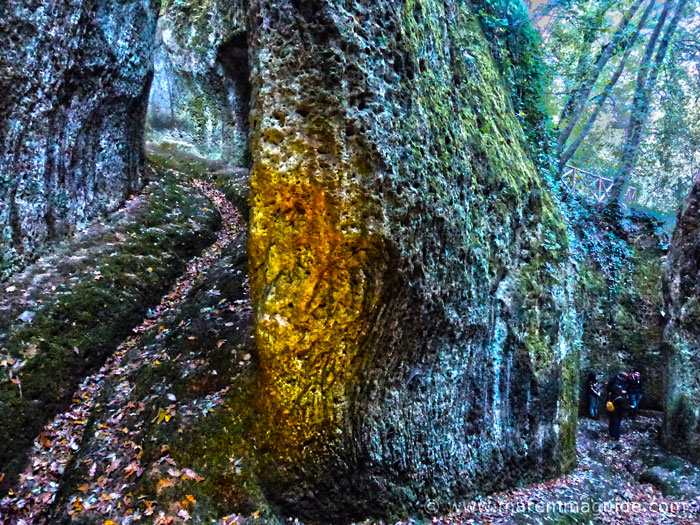
It once served as the main communication route between Sovana and Sorano and the mountain villages of Elmo, Montebuono and Montevitozzo.
Along its route you will find steps carved up into its sides that took people to small plots of agricultural land, high-up, alongside.
And niches. Tiny niches. That held "Scacciadiavoli". Sacred images placed along the walls to protect travellers from evil.
It will take you to the remains of fortifications, churches and more than two hundred caves that were once homes, barns, forges, carpenters workshops and more. At magical Vitozza. One of Italy's most important rock settlements.

Five kilometres there. And five back. Take a walk down the Via Cava di San Rocco at Sorano.
No time?
Will you dare to visit the dovecotes?
Closer still. Along the main road back to Sorano are the dovecotes in the rock wall.
NB. You need to go to the insediamento rupestre di San Rocco in the morning to take a decent photograph, as the afternoon sun floods over the tufa magical outcrops straight into your lens.

You will need to walk along the road - there isn't a pedestrian footpath, but there isn't a lot of passing traffic to worry about - to reach the iron access ladders.
If you dare climb them that is. To reach the ledge at the base of the caves.
Another ladder. And you can walk inside the rooms.

I didn't have time this time. It was already dusk. But. In the interests of showing you places that nobody else does in Tuscany. I will be going back. With my young assistant this time and maybe hubby to hold a torch or two.
Explore some more...



